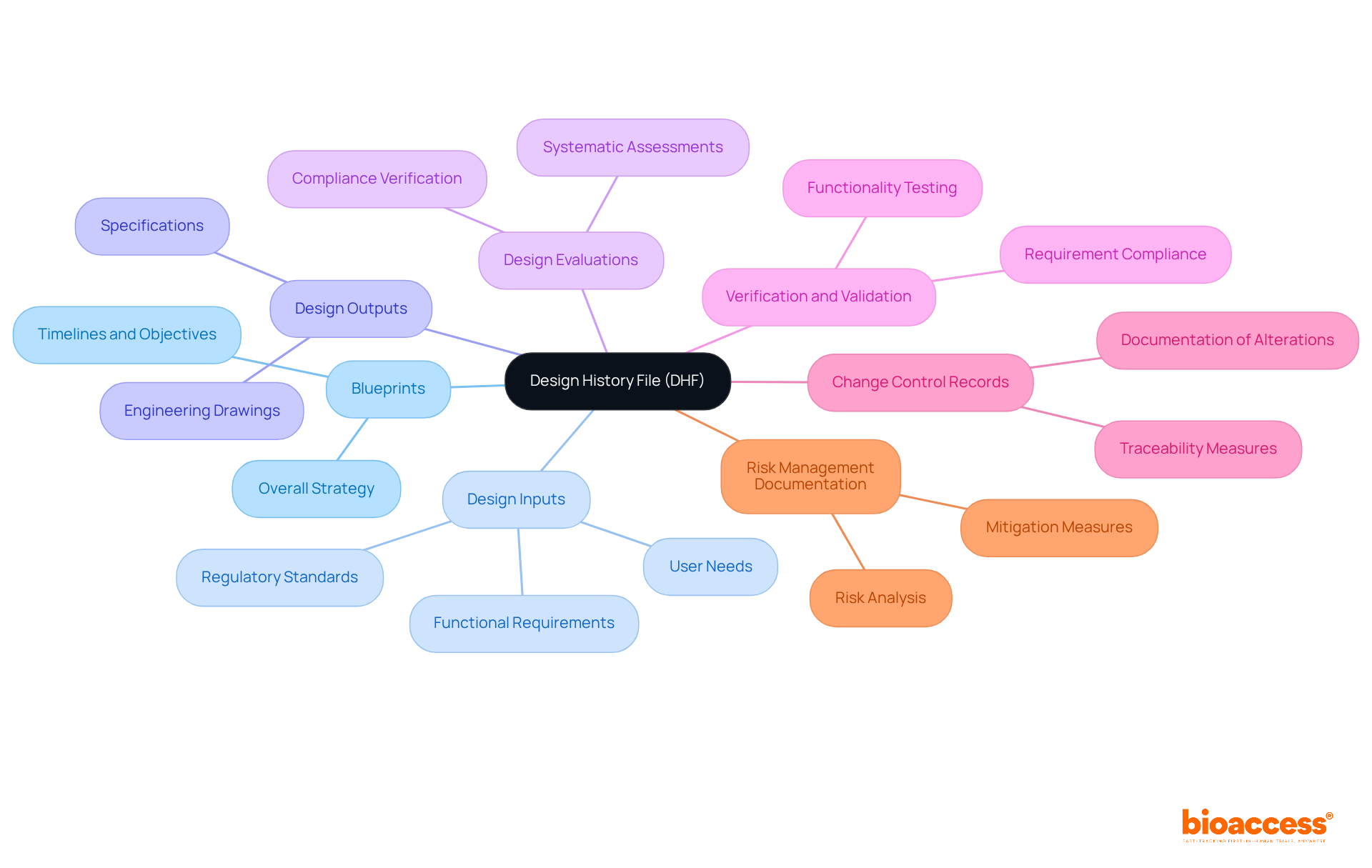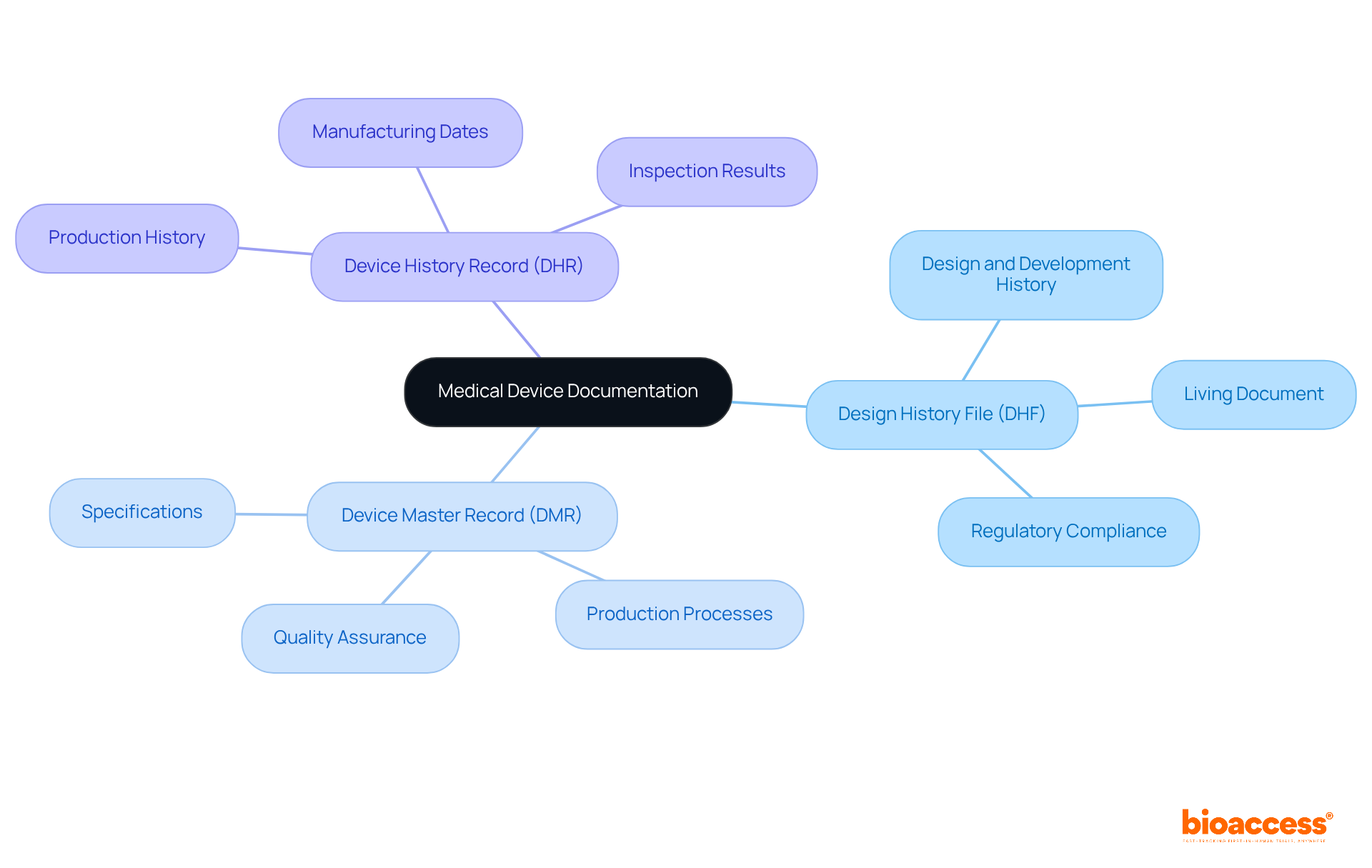


The complex realm of medical device development relies heavily on a crucial yet frequently overlooked component: the Design History File (DHF). This essential documentation not only meets regulatory requirements but also acts as a fundamental blueprint that guarantees safety, efficacy, and compliance throughout the device's lifecycle. With increasing scrutiny from regulatory bodies, manufacturers must ask themselves: how can they adeptly navigate the intricacies of DHF management to sidestep costly missteps and secure successful market entry?
Understanding the significance of the DHF is paramount for any organization aiming to thrive in the Medtech landscape. It serves as a comprehensive record that details the design and development processes, ensuring that every aspect of the device is meticulously documented. As the industry evolves, the role of the DHF becomes even more critical in addressing the challenges faced by manufacturers. By prioritizing effective DHF management, companies can not only enhance their compliance efforts but also bolster their reputation in a competitive market.
The design history file medical device serves as a comprehensive and meticulously organized collection of documentation that captures every facet of the creation and development processes. Established under the Safe Medical Devices Act of 1990, the design history file medical device is not just a regulatory requirement; it serves as a critical record that showcases adherence to standards mandated by the FDA. It must encompass all relevant and up-to-date documents that outline the creation and development process, ensuring thoroughness in documentation.
Key components of the design history file medical device include:
By meticulously documenting the evolution of the device from initial concept to final product, the design history file medical device ensures that all design decisions are well-documented and justified. This thorough documentation is essential for facilitating compliance during submissions. Moreover, the design history file medical device plays a vital role in ensuring the integrity and validation of the medical device throughout its lifecycle.
Utilizing document management software can significantly streamline the review and approval processes, enhancing the efficiency of DHF management. Poor management of the design history file medical device can lead to costly audits and failed FDA inspections, highlighting the necessity of maintaining a well-organized file. Additionally, the design history file medical device should seamlessly integrate with other records, such as the Device Master Record (DMR) and Device History Record (DHR), to ensure consistency and traceability in documentation.

The design history file medical device is a cornerstone in the medical equipment industry, serving as a comprehensive record that underpins regulatory submissions and audits. It meticulously documents every aspect of the development process, ensuring strict adherence to established guidelines, which significantly bolsters product safety and efficacy. Regulatory bodies, including the FDA, require a meticulously maintained design history file medical device to ensure that devices are developed in line with approved design controls.
Ana Criado, Director of Compliance Affairs and a professor in biomedical engineering, underscores the importance of a well-organized design history file medical device. Such a file can streamline interactions with oversight agencies, effectively minimizing the risk of delays in product approval and market entry. Furthermore, the DHF plays a pivotal role in quality assurance, fostering trust among stakeholders, including manufacturers, regulators, and patients. By maintaining a robust design history file medical device, companies not only comply with standards but also strategically position themselves for successful product launches and sustained market presence.

A thorough design history file medical device is essential for documenting the creation and development of medical devices, ensuring compliance with established standards. The DHF is mandated under FDA 21 CFR Part 820 and ISO 13485, highlighting its critical role in meeting regulatory requirements. Key components of an effective DHF include:
These elements together guarantee that the DHF provides a transparent and traceable record of the creation process, aiding adherence to compliance standards and increasing the chances of successful market entry. Furthermore, the DHF must be maintained throughout the product's lifecycle and be readily available for regulatory authorities to review. Creating and maintaining a DHF is a time-intensive and complex process, underscoring the importance of effective document management software to streamline DHF processes. Regular reviews and updates of the DHF are crucial to account for modifications or new information. Training team members on the significance of the DHF and documentation procedures is essential for compliance. The design history file medical device serves as a complete archive demonstrating that the medical instrument was developed according to established controls and requirements. It is also important to note that starting in 2026, the DHF requirement will be replaced by the Quality Management System Regulation (QMSR), which will maintain similar requirements.

In the realm of medical device documentation, the Design History File (DHF), Device Master Record (DMR), and Device History Record (DHR) are indispensable, each serving a unique purpose:
Design History File (DHF): This document chronicles the design and development history of the device, detailing its conception, design, and validation. It emphasizes the development process and compliance with regulatory standards. Importantly, the design history file medical device must be a living document, reflecting all modifications made throughout the design journey.
Device Master Record (DMR): Think of the DMR as the 'recipe' for the product. It encompasses specifications, production processes, quality assurance measures, and packaging requirements. This record is vital for ensuring consistent manufacturing that meets quality standards, with each DMR prepared in accordance with 21 CFR Part 820.40.
Device History Record (DHR): The DHR captures the production history of a specific item, including manufacturing dates, quantities produced, and inspection results. It serves as proof that each unit was produced according to the DMR and meets all specifications. Maintaining DHRs for each batch, lot, or unit is essential for manufacturers to demonstrate compliance with the DMR.
Grasping these distinctions is crucial for medical device developers to ensure a comprehensive design history file medical device and compliant documentation. Furthermore, it's important to recognize that the Quality Management System Regulation (QMSR) will supersede the Quality System Regulation (QSR) on February 2, 2026, leading to the replacement of the terms DMR, DHF, and DHR with the broader term Medical Device File (MDF). Additionally, ISO 13485:2016 does not utilize these terms, underscoring the necessity for clarity regarding international standards. Transitioning to electronic systems for document management can alleviate challenges associated with paper-based systems, thereby enhancing efficiency and compliance.

The Design History File (DHF) stands as a cornerstone in the development and regulation of medical devices, serving as a comprehensive record that meticulously documents every stage of a device's creation. This thorough documentation not only meets regulatory requirements but also plays a pivotal role in ensuring product safety and efficacy. By maintaining a well-organized DHF, manufacturers can effectively demonstrate compliance with FDA standards and streamline the approval process, ultimately enhancing their readiness for market entry.
Throughout this discussion, we have highlighted key aspects of the DHF, including its core components such as design inputs, outputs, evaluations, and risk management documentation. We clarified the distinctions between the DHF, Device Master Record (DMR), and Device History Record (DHR), emphasizing the unique roles each document plays in the lifecycle of medical devices. It is clear that a robust DHF is not merely beneficial for regulatory compliance; it is integral to fostering trust among stakeholders and ensuring quality assurance.
As the landscape of medical device regulation evolves, particularly with the impending transition to the Quality Management System Regulation (QMSR), the significance of a well-structured DHF cannot be overstated. Companies are encouraged to invest in effective document management solutions and training to keep their DHF current and compliant. By prioritizing the integrity of their design history files, manufacturers can position themselves for success in a competitive market, ultimately contributing to improved patient safety and healthcare outcomes.
What is a Design History File (DHF) in the context of medical devices?
The Design History File (DHF) is a comprehensive collection of documentation that captures every aspect of the creation and development processes of a medical device, established under the Safe Medical Devices Act of 1990.
Why is the Design History File important?
The DHF is crucial for showcasing adherence to FDA standards and serves as a critical record for compliance during submissions, ensuring the integrity and validation of the medical device throughout its lifecycle.
What key components should be included in a Design History File?
Key components of the DHF include plans, inputs and outputs, verification and validation activities, and any modifications made throughout the development lifecycle.
How does the Design History File contribute to the documentation of design decisions?
The DHF meticulously documents the evolution of the device from initial concept to final product, ensuring that all design decisions are well-documented and justified.
What tools can help manage the Design History File effectively?
Utilizing document management software can significantly streamline the review and approval processes, enhancing the efficiency of DHF management.
What are the consequences of poor management of the Design History File?
Poor management can lead to costly audits and failed FDA inspections, emphasizing the necessity of maintaining a well-organized DHF.
How should the Design History File relate to other records?
The DHF should seamlessly integrate with other records, such as the Device Master Record (DMR) and Device History Record (DHR), to ensure consistency and traceability in documentation.